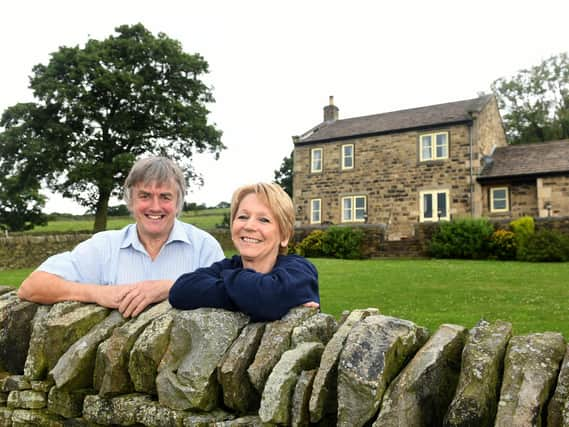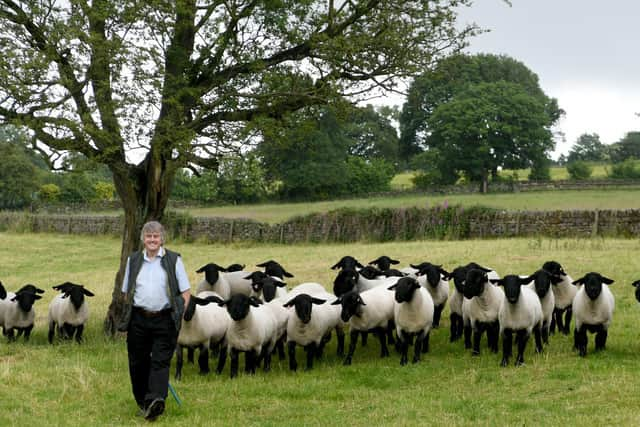Meet the Sheffield steelworker's son who funded his sheep farming dream by delivering frozen chips


South Yorkshire farmer John Key has farmed at Midhopestones,near Stocksbridge, since 1975, having started out on his sister’s 23 acres in Derbyshire five years previously. John said he established his pedigree Suffolk flock 40 years ago and that performance recording and responding to the results have been his guiding principles.
“I started the flock when I bought half a dozen ewes, new lambs and a ram from a chap on the Yorkshire coast. They were good ewes from a flock called Lightash. I’d tried Texels before going with Suffolks, but couldn’t get on with them. I liked the Suffolk and I still believe the breed has a lot to offer as a terminal sire with its ability to grow fast and be a reliable finisher.
Advertisement
Hide AdAdvertisement
Hide Ad“I think it is important you find your best lines for traits of meat production, conformation and ability to grow quickly. That’s why, since the late 1980s I have recorded all the time.”


Recording results and having statistics at hand are a vital tool in John’s sales armoury. It is one of the main reasons why buyers keep returning to his Midhope Suffolks flock at Garfield House Farm.
“We use Signet Recording and carry out an eight-week weight of lambs which gives us an indication of the fastest growing lambs and tells us the ewes that are really milky. That helps with the maternal index. When you’re selling the Suffolk to people who want to produce crossbred gimmer lambs out of Mules their main concern is that they want them to grow quickly.
“We also weigh at 20 weeks when we scan the lamb for depth of eye muscle and the amount of fat over it. This calculates the meat to bone ratio and in particular the loin. It provides a much better indication of the amount of meat in the lamb.
Advertisement
Hide AdAdvertisement
Hide AdJohn’s flock runs to 80 Suffolk ewes. He said he’s a big believer in artificial insemination and synchronising lambing so that it generally takes place in the shortest timeframe.
“They should all lamb around the second week of January. We start our programme now, with teasers going in last weekend putting in melatonin to encourage oestrous activity. We then sponge at the end of July ready for our AI date of around August 13-14. On the day I also have my own stock rams and an occasional bought-in stock ram that we will use fresh semen to inseminate the ewes and we will have frozen semen from proven rams from other flocks.”
John said his greatest success with a homebred tup came via initially purchasing semen from a fellow breeder.
“We bought semen from Hans Porksen who farms in Northumberland. That tup’s semen did my flock the power of good and bred us a tup in 2016 that we named Midhope Hans Solo. That ram has done very well for us and has bred us rams that have gone into other pedigree Suffolk flocks all over the country.
Advertisement
Hide AdAdvertisement
Hide Ad“Midhope Hans Solo’s figures show that he is excellent on conformation, growth and carcase. He is so highly regarded that he was used in the Signet Ram Compare Project 2020 and came out as the top Suffolk for carcase traits and days before lambs go to processing.
“We are basically commercial ram producers, that’s what all pedigree producers are. Our role is to provide the best of the best to ensure commercial flocks maintain and improve their flocks to send quality lamb to market.”
During the pandemic, John’s sales of rams and ram lambs direct from the farm have been on the increase. John said they did manage to get to some breed sales too and that he is presently readying himself for the annual national Suffolk breed sale at Shrewsbury at the end of this month.
“Last year proved a very good year for the sheep trade all round whether it was stores sales or fat lambs. The ram trade was good too. We sold 50 rams and ram lambs from home. That’s more than we would normally do.”
Advertisement
Hide AdAdvertisement
Hide AdWith a prolificacy of around 175 per cent John usually has around 140-150 lambs born every year.
John has a suckler herd of 50 Shorthorn-cross cows that he started with when he moved up the hill from his previous farmhouse by the side of the main road to the newly built Garfield House Farm in 2000. He said he also keeps five purebred Belgian Blue cows.
“We’ve had two Shorthorn bulls over the last three or four years, which we’ve put back to the herd that previously had Belgian Blue and Limousin bulls. We’re now getting towards half or three-quarter Shorthorns. The five purebred Belgian Blue cows I’m playing with to try and breed a good bull. ”
John’s farming destiny started when he stayed on a farm when in his teens. He said everything that has happened since emanated from then.
Advertisement
Hide AdAdvertisement
Hide Ad“I was with the Boy Scouts and I ended up getting a job with the farmer Robert Purseglove at Foolow near Eyam in Derbyshire where he had Ayrshire cows. That led me to studying at Harper Adams, which were the best two years of my life, learning and meeting loads of wonderful people.
“My sister and her husband bought a small farm near where I was working and I started farming it. I had 20 sows producing weaners, bought calves to take to stores out of Bakewell Mart and had 30 ewes with a Suffolk tup.
“In 1975 I took the tenancy here thanks to a very good reference from Dairy Shorthorn farmer John Milnes. It was 80 acres and a Yorkshire Water farm. I now own 60 acres and with rented land I farm 240 acres. My wife Fiona and I lived in a caravan for a while when we moved up the hill.”
John is also involved in stewardship schemes on the farm and works with the RSPB on a bird management project to enhance species such as lapwing, curlew and snipe.